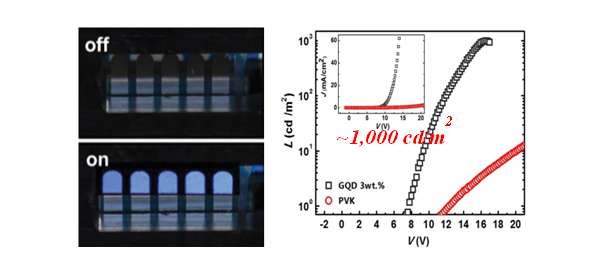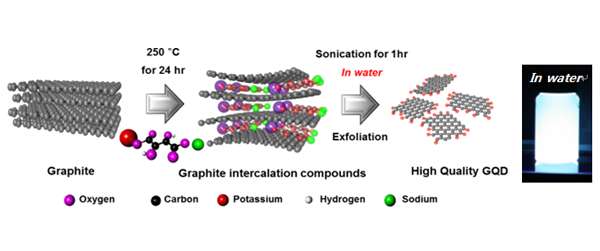Graphene quantum dot LEDs

The first graphene quantum dot light-emitting diodes (GQD-LEDs), fabricated by using high-quantum-yield graphene quantum dots through graphite intercalation compounds, exhibit luminance in excess of 1,000 cd/m2.
Graphene is a 2D carbon nanomaterial with many fascinating properties that can enable to creation of next-generation electronics. However, it is known that graphene is not applicable to optical devices due to its lack of an electronic band gap. On the other hand, graphene quantum dots (GQDs), which are merely a few nanometers large in the lateral dimension, are shown to emit light upon excitation in the visible spectral range. The GQDs have attracted a great deal of attention as a next-generation luminescent material for their outstanding properties: tunable luminescence, superior photostability, low toxicity, and chemical resistance.
Recently, Prof. Seokwoo Jeon (Material Science and Engineering), Prof. Yong-Hoon Cho (Physics), and Prof. Seunghyup Yoo (Electrical Engineering) have succeeded in developing LEDs based on graphene quantum dots. Highly pure GQDs were synthesized by an environmentally-friendly method designed by Prof. Jeon's group, their light-emitting mechanisms were carefully studied by Prof. Cho's group with their transient spectroscopic technique, and finally Prof. Yoo's group brought their OLED expertise to create GQD-based LEDs.
The GQDs with high luminance tunability and efficiency were synthesized by a route based on graphite intercalation compounds (GICs). The proposed method is cost-effective, eco-friendly, and scalable, as it allows direct fabrication of GQDs using water without surfactant or chemical solvent.
GQDs were then used as emitters in organic light-emitting diodes (OLEDs) in order to identify the GQD's key optical properties. After carefully designing the layer configuration so that electron and hole injection could be balanced, the constructed GQD LEDs exhibited luminance of 1,000 cd/m2, which is well over the typical brightness levels of the portable displays used in smartphones. Considering how thin GQDs are, a foldable paper-like display could soon become a reality.

The present work, for the first time, demonstrated that GQDs can be applied to optical devices by fabricating GQD-based LEDs with meaningful brightness. Although, the efficiency of GQD-based LEDs is currently less than those of conventional LEDs, they are expected to improve in the near future with an optimized material process and device structure.
This research was published as a cover article in Advanced Optical Materials (Vol.2, 1016-1023 (2014)), a premier journal that features significant advances in optical materials and devices based upon them.
Journal information: Advanced Optical Materials



















